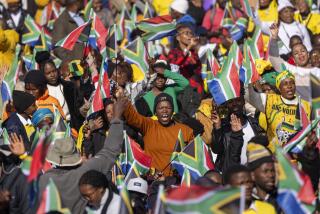World Cup comes too late for a star player
- Share via
Reporting from Atteridgeville, South Africa — At 60, he walks like an old man, hobbling slowly out of his room, sitting stiffly on a plastic chair in the house he grew up in, with its corrugated tin roof, cheap furniture and glass cabinet crowded with faded mementos.
He absently touches his swollen right knee, the old soccer injury that cut short his career and sent him home to Atteridgeville and a life spent selling shoes in a sporting goods store.
But here in the township outside Pretoria where he was born, he will always be a hero.
“Everyone who knows South African soccer knows me,” he croaks softly, smiling, in the days before his country will host the sport’s quadrennial World Cup.
His name is Lucas Moripe, but in the township they call him something else: Masterpieces.
***
Soccer was imported to Africa in the 1860s by British soldiers and promoted by colonial authorities, missionaries and mining executives, who saw it as part of their “civilizing” mission, said Peter Alegi, who teaches African history at Michigan State University and is the author of “African Soccerscapes.”
In South Africa, Indian- and African-run soccer leagues sprang up. For blacks living under apartheid, soccer became entwined with racial identity, community pride, politics and the struggle for freedom.
Playing soccer or running a club or league was among the only ways a black man could achieve status. Most players earned a meager amount. But by the logic of apartheid, soccer wasn’t considered real work, and a black professional player could be arrested for being unemployed and sent to the countryside to work for a farmer.
Yet some of those who organized the leagues and clubs grew wealthy by black standards — one of the few legal means for a black man to do so.
African National Congress leaders saw the sport, called football in most of the world, as a means to attract young people to politics. Political rallies and meetings were advertised at soccer games, and ANC meetings were sometimes held after matches.
Inmates on Robben Island, the notorious prison where Nelson Mandela spent 18 of his 27 years in captivity, played in their own league.
Like everything in South Africa, soccer was segregated, and efforts to integrate the sport played their part in the wider liberation struggle.
In 1929, mine company clerks and white do-gooders formed a black Bantu soccer league in Johannesburg. The rival Johannesburg African Football Assn., or JAFA, which resisted cooperation with the white minority government, split off in 1933.
The Bantu league, supported by the apartheid regime, was given training and facilities. JAFA teams played on any spare piece of ground, with homemade goal posts.
In 1950, a black South African team was invited to play in Congo. The government proposed sending a Bantu-JAFA team under a white manager.
The leader of JAFA, Dan Twala, rejected the idea. “There is no European in our executive, and we cannot think of anyone who could fill this position adequately other than our own African man,” he wrote.
The compliant Bantu league squad was sent instead.
It lost.
In 1951, the struggle to eliminate racial separation took a step forward with the launch of the South African Soccer Federation, representing 46,000 black, mixed-race and Indian players, 80% of the country’s registered footballers.
A year later, FIFA, soccer’s international governing body, admitted a white minority league, the South African Football Assn., even though it represented only 20% of players. But a campaign to expel South Africa from FIFA gained momentum after the 1960 Sharpeville massacre, when police opened fire on black protesters, killing 69.
FIFA declared that any national football association must be open to all players regardless of race, and in 1961, it suspended South Africa.
But efforts to turn the suspension into an expulsion were frustrated by a conservative Briton, Stanley Rous, FIFA’s president from 1961 to 1974. He maintained that politics and soccer shouldn’t mix. Finally in 1976, South Africa was kicked out of the organization, a major blow to the apartheid government.
Leepile Taunyane, 82, was one of many black soccer officials who fought apartheid through their sport and for whom the FIFA expulsion was a great victory.
“There was this constant banging against the barriers of the nationalist, ideological policy of the government,” said Taunyane, president-for-life of South Africa’s Premier Soccer League. “Football was among the first sporting bodies that constantly banged against this barrier. It was a constant struggle. We knew what we were doing, and we knew what we were fighting against.”
***
Lucas Moripe was like nearly every urban African boy: addicted to soccer.
“We played in bare feet. We used tennis balls. Boys from one street would play the next street. I was just playing and I didn’t even realize I had talent.”
His father, a laborer, died young, and Moripe had to leave school at 13 to work as a delivery boy. He practiced soccer in his spare moments. He danced the ball through the dust, dodging, feinting and weaving, sometimes leaving his opponents sprawled on the ground. Even rival players laughed at his magic.
Joe Latakgomo, a soccer writer for the World newspaper who wrote a history of the sport in South Africa, “Mzansi Magic,” had heard so much about the young player that he decided to go to Atteridgeville to see for himself.
The township was buzzing. The bars had emptied. A river of people streamed toward the stadium. Everyone was talking about the same thing: Masterpieces, and what he’d do that day. Fans called him “the god of football.”
When he ran onto the field at Atteridgeville Stadium, the crowd went wild.
“It was his skill,” Latakgomo said in an interview. “He did things so instinctively. He never did the same thing twice. Other players have one particular style, but with Masterpieces nobody knew what he was going to do, including his own team players.
“He could do things with the ball that nobody else could.”
Moripe called it “making the ball talk to me.”
His team won that day, but the final score was secondary.
“Everyone wanted to touch me and shake my hand,” Moripe said. “The level of cheering was so great that I’d look back and say, ‘These people really expect me to do things for the team.’ And I was determined not to let them down.”
Masterpieces was named his league’s player of the year in 1973 and was sent to Britain for two weeks to train top players.
He played professionally in Hong Kong for several years, but didn’t flourish, partly, he said, because he couldn’t understand much of what the coach said. Moripe’s education was limited and his English was poor. He eventually asked to be released, and returned to South Africa.
In 1979, a severe knee injury forced him to retire.
He is one of South Africa’s many “could-have-beens”: talented black and white players who never appeared in a World Cup or got a chance to shine on the international stage.
“Apartheid affected all of us,” Masterpieces said. “Many players could have been great players, but we didn’t have the facilities. … Can you imagine what we could have done, if we’d had all the advantages?”
After the post-apartheid elections of 1994, South Africa was infused with hope under the first democratically elected president, Nelson Mandela. He donned the South African rugby team shirt in 1995 after its Rugby World Cup victory on home turf, a unifying moment portrayed in the film “Invictus.”
When South Africa was granted the right to host the soccer World Cup at a ceremony in Zurich, Switzerland, in 2004, Mandela wept.
Yet 16 years after apartheid ended, racial divisions live on in sports. Rugby is still largely a white game, attended mainly by whites. Soccer remains a black game, on the field and in the stands. Online commentaries urging support for Bafana Bafana, the national soccer team, often degenerate into racial spats.
Masterpieces never got rich. And like millions of poor South Africans, his life hasn’t changed much since apartheid ended.
But in Atteridgeville, people still call out his name when they see him on the street. The local stadium, which will be used for training during the World Cup, was recently renamed for him.
“I’ve seen him in the streets,” said Tumi Sematse, 27, a soccer fan from Atteridgeville who had been waiting in line for 13 hours to buy World Cup tickets. “He’s limping, the old man. He’s still big. There’s still honor.”
“Normally we name stadiums and streets after people who are dead,” she said. “This guy is still alive. And he’s a legend.”
More to Read
Go beyond the scoreboard
Get the latest on L.A.'s teams in the daily Sports Report newsletter.
You may occasionally receive promotional content from the Los Angeles Times.






